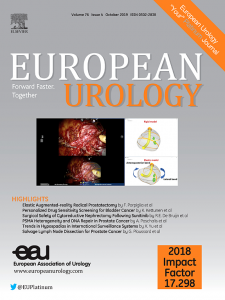Prevalence, Socioeconomic, and Environmental Costs of Urinary Incontinence in the European Union
IF 25.3
1区 医学
Q1 UROLOGY & NEPHROLOGY
引用次数: 0
Abstract
Background and objective
Up to 40% of the population suffers from urinary incontinence (UI). UI can be managed through qualified early assessment, possibly reducing associated health care costs. However, limited studies have estimated the economic burden of UI in the European Union (EU). This study estimates the economic burden of UI on individuals, carers, health systems, long-term care, and society in the EU.Methods
Prevalence data were extracted or estimated to inform the epidemiological burden of UI in the EU. The economic burden of UI in 27 EU member states was then estimated, which included direct and indirect productivity losses and incontinence pad disposal costs. The 2023 results were presented, and projections for 2030 were estimated for future costs if no preventative action is taken. All costs were expressed in euros (EUR€).Key findings and limitations
In 2023, the EU economic burden of UI was EUR€69.1 billion (EUR€26.1–133.4 billion) without caregiver costs, with females bearing quadruple the burden compared with males. On average, per-patient annual costs were EUR€1,470.6. Caregiver costs increased EU economic burden to EUR€80.0 billion (EUR€32.5–150.6 billion) with per-patient per-year costs increasing to EUR€1,700.0. In 2030, the economic burden could rise to EUR€100.2 billion (EUR€40.8–188.6 billion). Shifting to 100% incontinence pad waste recycling could reduce the overall carbon footprint of continence health in Europe by 117.8 million kg CO2e in 2023.Conclusions and clinical implications
A high UI economic burden emphasises the economic and environmental benefits of prevention. The results highlight the need for recognising the high economic burden in women, improved prevalence data surveillance driving effective prevention strategies, and formally recognising secondary caregivers in the UI treatment pathway.欧盟尿失禁的患病率、社会经济和环境成本
背景与目的高达40%的人口患有尿失禁(UI)。可通过合格的早期评估来管理失尿症,从而可能降低相关的保健费用。然而,有限的研究估计了欧盟(EU)的UI经济负担。本研究估计了欧盟个人、护理人员、卫生系统、长期护理和社会的经济负担。方法提取或估计流行率数据,了解欧盟地区尿失速的流行病学负担。然后估计了27个欧盟成员国的尿失禁经济负担,其中包括直接和间接的生产力损失以及尿失禁垫处理成本。提出了2023年的结果,并估计了如果不采取预防措施,2030年的未来成本。所有成本均以欧元(EUR€)表示。2023年,不包括护理费用,欧盟因老年痴呆症造成的经济负担为691亿欧元(261 - 1334亿欧元),其中女性的负担是男性的四倍。每位患者的年平均费用为1470.6欧元。护理人员成本增加了欧盟的经济负担,达到800亿欧元(325 - 1506亿欧元),每位患者每年的成本增加到1,700欧元。到2030年,经济负担可能上升到1002亿欧元(408 - 1886亿欧元)。转向100%的失禁垫废物回收可以在2023年将欧洲失禁健康的总碳足迹减少1.178亿公斤二氧化碳当量。结论和临床意义高尿失尿经济负担强调了预防的经济和环境效益。结果强调,需要认识到妇女的高经济负担,改进流行数据监测,推动有效的预防战略,并正式承认在尿失尿治疗途径中的二级护理人员。
本文章由计算机程序翻译,如有差异,请以英文原文为准。
求助全文
约1分钟内获得全文
求助全文
来源期刊

European urology
医学-泌尿学与肾脏学
CiteScore
43.00
自引率
2.60%
发文量
1753
审稿时长
23 days
期刊介绍:
European Urology is a peer-reviewed journal that publishes original articles and reviews on a broad spectrum of urological issues. Covering topics such as oncology, impotence, infertility, pediatrics, lithiasis and endourology, the journal also highlights recent advances in techniques, instrumentation, surgery, and pediatric urology. This comprehensive approach provides readers with an in-depth guide to international developments in urology.
 求助内容:
求助内容: 应助结果提醒方式:
应助结果提醒方式:


